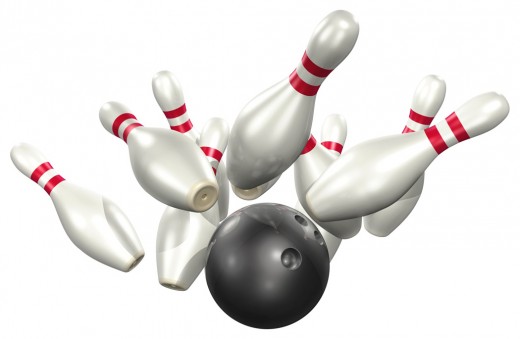Bowling Score How To Guide
How to Score Bowling
Bowling is a seemingly simple game. Roll a large black ball down a narrow lane and hit the white objects, called bowling pins, at the end of the lane. If your ball goes too far off course, it goes into the gutter, and if you don’t knock down all ten pins on your first try, you get a second try to knock down whatever pins are left. However, this simplicity is deceiving. Scoring a bowling game is actually a bit complex, at least until you grasp the concept. Fortunately, bowling scores follow a handful of simple and consistent rules.
Don’t get overwhelmed in the beginning. It sounds like a lot, but once you see it in action, there isn’t a lot to it.

Spares, Strikes, Frames, Bowling Games
If you do knock down the rest of the pins, that is called a spare. If you managed to knock down all 10 bowling pins on the first try, that is called a strike, and you don’t get a second roll, though you don’t need one.
Each one or two roll attempt to knock down the ten bowling pins is called a frame. There are 10 frames in one game of bowling. If a spare or strike is scored on the final, or tenth frame, the bowler is allowed either one bonus roll, in the case of a spare, or two bonus rolls in the case of a strike. Regardless of whether or not the bowler rolls strikes or spares, no bonus frames are allotted past two.
A typical bowling score sheet show blank boxes for each frame, plus a set of boxes for the additional rolls a bowler gets for scoring a spare or strike in the last frame. Although each frame does get a score, it is not always possible to fill in a particular frame’s score at the end of the bowler’s turn. This is because some scoring requires knowing the score of subsequent turns.
Scoring a Bowling Frame
The most basic bowling score involves simply recording one point for each pin the bowler knocked down. This is not the case if the bowler does knock down all ten pins on either the first or second try.
If the bowler does not knock down all ten pins, then the score for that frame is just the number that were successfully knocked over. For example, if a bowler hits 5 pins with the first roll, and 3 pins with the next roll, then the score for that frame is 8.
If the bowler knocks over all ten pins with the first try, a strike, then the bowler does indeed get 10 points for knocking down all the bowling pins. However, that isn’t all the points for that frame. Instead, the bowler gets to count the results of the next two rolls, regardless of their outcome, as additional points for that frame.
If the bowler knocks over all ten pins after two rolls, a spare, the number of pins knocked down on the bowler’s next roll, regardless of outcome, is added to the frame’s score.
Subsequent Strikes and Spares
An additional complication arises when the bowler achieves a strike and then scores a strike on the next roll. Since the bowler is allowed to count the next two rolls toward the score in the first frame, a subsequent strike gives the bowler 10 more points for that frame. However, the bowler is still allowed to count the points from the next roll as well toward the original frame.
This means that in the case of multiple sequential strikes, a frame may require waiting for the results of two more frames, or turns, for the bowler to know the score of the original frame. In addition, the subsequent frame also cannot be scored immediately as the bowler gets to count the results of the two rolls after that strike toward the score in the second frame. Thus, it is possible that two frames in a row will have open scores.
After the third roll, the score in the first frame can be calculated. However, many bowlers subscribe to a superstition that claims bad luck for filling in a frame’s score before the bowler has stopped rolling consecutive strikes. Therefore, most bowlers will wait until the string of strikes is broken before calculating the bowler’s score, even if there is enough data to complete a frame’s score.
Added all up the best possible score for a single game of bowling is 300 which is achieved when the bowler rolls a strike for every regulation frame, and a strike for each of the two bonus frames.
About the Writer
Hub Llama is the HubPages pseudonym for Brian Nelson from the professional freelance writing business called Arctic Llama. Brian also writes a freelance writing blog with tips and techniques for both writers and those who hire them.
As a former financial planner, CFP, and systems administrator, MCSE, as well as a father to two young children, Brian writes on numerous topics including personal finance, technology, and parenting skills for dads.



